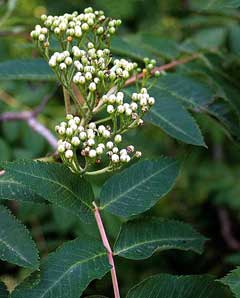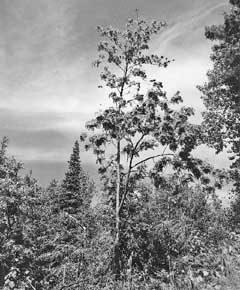 |
|
http://commons.wikimedia.org/wiki/User:Hedwig_Storch |
 |
| P. Freeman Heim @ USDA-NRCS PLANTS Database |
Translate this page:
Summary
Physical Characteristics

 Sorbus decora is a deciduous Tree growing to 10 m (32ft) by 8 m (26ft).
Sorbus decora is a deciduous Tree growing to 10 m (32ft) by 8 m (26ft).
See above for USDA hardiness. It is hardy to UK zone 2. It is in flower from May to June. The species is hermaphrodite (has both male and female organs) and is pollinated by Insects.
Suitable for: light (sandy), medium (loamy) and heavy (clay) soils, prefers well-drained soil and can grow in nutritionally poor soil. Suitable pH: mildly acid, neutral and basic (mildly alkaline) soils. It can grow in semi-shade (light woodland) or no shade. It prefers moist soil. The plant can tolerates strong winds but not maritime exposure.
UK Hardiness Map
US Hardiness Map
Synonyms
Plant Habitats
Woodland Garden Canopy; Secondary; Sunny Edge;
Edible Uses
Edible Parts: Fruit
Edible Uses:
Fruit - raw or cooked in preserves etc[183]. The taste is best after a frost[101]. The fruits are about 7 - 10mm across and are borne in dense clusters[200].
References More on Edible Uses
Medicinal Uses
Plants For A Future can not take any responsibility for any adverse effects from the use of plants. Always seek advice from a professional before using a plant medicinally.
Analgesic Antirheumatic
A decoction of the inner bark, taken from the stem base, has been used as a wash and poultice in the treatment of rheumatism[257]. The decoction can also be taken internally in the treatment of a backache[257]. A decoction of the peeled stems has been drunk in the treatment of backaches[257].
References More on Medicinal Uses
The Bookshop: Edible Plant Books
Our Latest books on Perennial Plants For Food Forests and Permaculture Gardens in paperback or digital formats.

Edible Tropical Plants
Food Forest Plants for Hotter Conditions: 250+ Plants For Tropical Food Forests & Permaculture Gardens.
More

Edible Temperate Plants
Plants for Your Food Forest: 500 Plants for Temperate Food Forests & Permaculture Gardens.
More

More Books
PFAF have eight books available in paperback and digital formats. Browse the shop for more information.
Shop Now
Other Uses
Pioneer Wood
This species is capable of growing in exposed conditions in poor soils[229], and so could be used in re-afforestation as a pioneer plant to provide suitable conditions for other woodland trees to be established[K]. Wood - close-grained, soft, moderately light with little strength, it is of no commercial value[229].
Special Uses
Food Forest
References More on Other Uses
Cultivation details
Succeeds in most reasonably good soils in an open sunny position[11]. Dislikes dry soils[188]. Tolerates light shade[188], though it fruits better in a sunny position[K]. This species is able to grow in poor soils and to become established on exposed broken ground[229]. Plants are susceptible to fireblight[188]. Closely related to S. americana[11]. The plant is heat tolerant in zones 8 through 1. (Plant Hardiness Zones show how well plants withstand cold winter temperatures.
Plant Heat Zones show when plants would start suffering from the heat.
The Plant Heat Zone map is based on the number of "heat days" experienced in a given area where the temperature climbs to over 86 degrees F (30°C).
At this temperature, many plants begin to suffer physiological damage. Heat Zones range from 1 (no heat days) to 12 (210 or more heat days).
For example Heat Zone. 11-1 indicates that the plant is heat tolerant in zones 11 through 1.) For polyculture design as well as the above-ground architecture (form - tree, shrub etc. and size shown above) information on the habit and root pattern is also useful and given here if available. The plant growth habit is a standard with a non-suckering single trunk [1-2]. The root pattern is flat with shallow roots forming a plate near the soil surface [1-2].
References Carbon Farming Information and Carbon Sequestration Information
Temperature Converter
Type a value in the Celsius field to convert the value to Fahrenheit:
Fahrenheit:
The PFAF Bookshop
Plants For A Future have a number of books available in paperback and digital form. Book titles include Edible Plants, Edible Perennials, Edible Trees,Edible Shrubs, Woodland Gardening, and Temperate Food Forest Plants. Our new book is Food Forest Plants For Hotter Conditions (Tropical and Sub-Tropical).
Shop Now
Plant Propagation
Seed - best sown as soon as it is ripe in a cold frame[78, 80]. If you have sufficient seed it can be sown in an outdoor seedbed[78, 80]. Stored seed germinates better if given 2 weeks warm then 14 - 16 weeks cold stratification[98], so sow it as early in the year as possible. Prick out the seedlings into individual pots when they are large enough to handle. Seedlings are very slow to put on top-growth for their first year or two[11], but they are busy building up a good root system. It is best to keep them in pots in a cold frame for their first winter and then plant them out into their permanent positions in late spring.
Other Names
If available other names are mentioned here
Native Range
NORTHERN AMERICA: Greenland (south), Canada, Québec, Nova Scotia, Ontario, Prince Edward Island, New Brunswick, Newfoundland and Labrador, Saskatchewan, Manitoba, United States, Indiana (north), Maine, Massachusetts, Michigan, New Hampshire, New York, Pennsylvania (north), Vermont, Minnesota,
Weed Potential
Right plant wrong place. We are currently updating this section.
Please note that a plant may be invasive in one area but may not in your area so it's worth checking.
Conservation Status
IUCN Red List of Threatened Plants Status :

Growth: S = slow M = medium F = fast. Soil: L = light (sandy) M = medium H = heavy (clay). pH: A = acid N = neutral B = basic (alkaline). Shade: F = full shade S = semi-shade N = no shade. Moisture: D = dry M = Moist We = wet Wa = water.
Now available:
Food Forest Plants for Mediterranean Conditions
350+ Perennial Plants For Mediterranean and Drier Food Forests and Permaculture Gardens.
[Paperback and eBook]
This is the third in Plants For A Future's series of plant guides for food forests tailored to
specific climate zones. Following volumes on temperate and tropical ecosystems, this book focuses
on species suited to Mediterranean conditions—regions with hot, dry summers and cool, wet winters,
often facing the added challenge of climate change.
Read More
Expert comment
Author
(Sarg.)Schneid.
Botanical References
1143200
Links / References
For a list of references used on this page please go here
Readers comment
© 2010, Plants For A Future. Plants For A Future is a charitable company limited by guarantee, registered in England and Wales. Charity No. 1057719, Company No. 3204567.